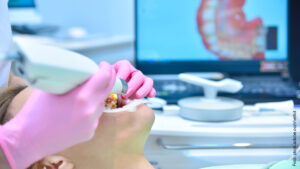Harmonische Weichgewebsheilung
Die Straumann Ceramic Gingivaformer für Bone Level und Bone Level Tapered Implantate begünstigen die Bildung des epithelialen Attachments und unterstützen eine gesunde periimplantäre Umgebung. Das bewährte Material Zirkondioxid reduziert Plaqueansammlungen und fördert die Heilung der oralen Weichgewebe bereits ab dem Tag des chirurgischen Verfahrens.

Der erste Keramik-Gingivaformer in der Geschichte von Straumann © Straumann
Im Vergleich mit Titan trägt Zirkondioxid insgesamt zu einer verbesserten Bildung der epithelialen Attachments bei sowie zu einer ausgeprägten Weichgewebsintegration. Die periimplantäre Gewebedurchblutung ist mit der um den natürlichen Zahn vergleichbar 1-7. Dank der glatteren Oberfläche von Zirkondioxid kommt es nachweislich zu einer geringeren Plaqueadhäsion verglichen mit Titan 2–3,8–9.
Für optimale ästhetische Ergebnisse empfiehlt Straumann die definitive Versorgung mit den CARES Keramikoptionen.
Besonders anwenderfreundlich ist die integrierte Schraube, die den Patienten vor Aspiration schützt. Die Farbkodierung erleichtert die eindeutige Identifikation der zugehörigen prothetischen Plattform.
www.straumann.de/ceramic-gingivaformer
Literatur
1 Kajiwara N, Masaki C, Mukaibo T, Kondo Y, Nakamoto T, Hosokawa R (2015). Soft tissue biological response to zirconia and metal implant abutments compared with natural tooth: microcirculation monitoring as a novel bioindicator. Implant Dent 24(1):37-41.
2 Degidi M, Artese L, Scarano A, Perrotti V, Gehrke P, Piattelli A. Inflammatory infiltrate, microvessel density, nitric oxide synthase expression, vascular endothelial growth factor expression, and proliferative activity in peri-implant soft tissues around titanium and zirconium oxide healing caps. J Periodontol. 2006 Jan;77(1):73-80.
3 Liñares A, Grize L, Muñoz F, Pippenger BE, Dard M, Domken O, Blanco-Carrión J. Histological assessment of hard and soft tissues surrounding a novel ceramic implant: a pilot study in the minipig. J Clin Periodontol. 2016 Jun;43(6):538-46.
4 Erbshäuser M., Zirconium dioxide dental implants in single-tooth gaps – An alternative to titanium? (Article in German). Implantologie Journal 11 | 2015, 32-36.
5 Welander M, Abrahamsson I, Berglundh T. The mucosal barrier at implant abutments of different materials. Clin Oral Implants Res. 2008 Jul;19(7):635-41.
6 Tetè S, Mastrangelo F, Bianchi A, Zizzari V, Scarano A. Collagen fiber orientation around machined titanium and zirconia dental implant necks: an animal study. Int J Oral Maxillofac Implants. 2009 Jan-Feb;24(1):52-8.
7 De Medeiros RA, Vechiato-Filho AJ, Pellizzer EP, Mazaro JV, dos Santos DM, Goiato MC (2013). Analysis of the peri-implant soft tissues in contact with zirconia abutments: an evidence-based literature review. J Contemp Dent Pract 14(3):567- 572.
8 S. Roehling, M. Astasov-Frauenhoffer, I. Hauser-Gerspach, O. Braissant, H. Engelhardt, T. Waltimo, M. Gahlert. In vitro biofilm formation on commercially available machined and micro-roughened titanium and zirconia implant surfaces. Clin. Oral Impl. Res. 26 (Suppl. 12), 2015.
9 Scarano A, Piattelli M, Caputi S, Favero GA, Piattelli A. Bacterial adhesion on commercially pure titanium and zirconium oxide disks: an in vivo human study. J Periodontol. 2004 Feb;75(2):292-6.





